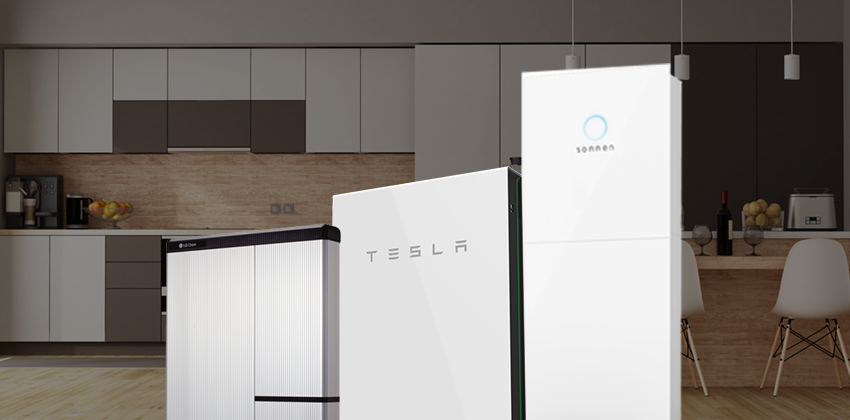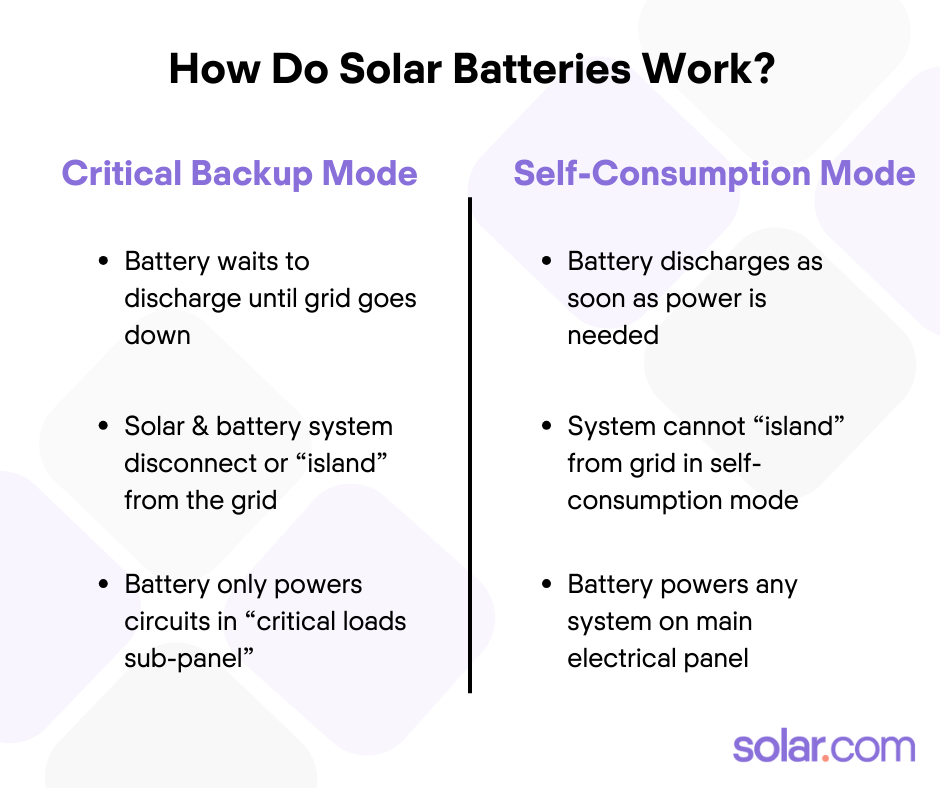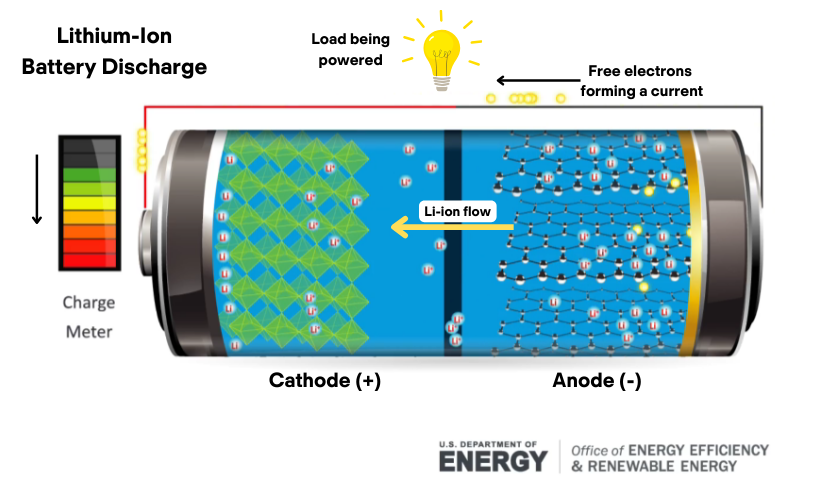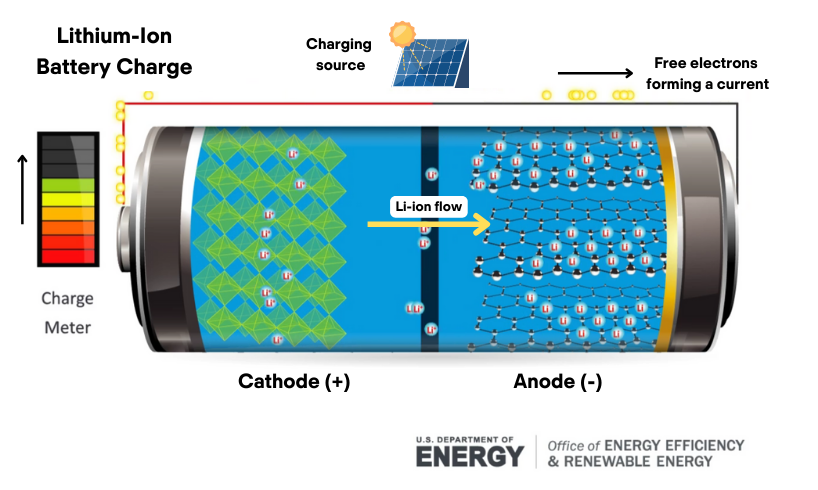See how much solar panels cost in your area

Please enter a valid zip code.
Zero Upfront Cost
Best Price Guaranteed
![]()
![]()
Solar Learning Center > Solar Battery > How Do Solar Batteries Work?
How Do Solar Batteries Work?

Lithium-ion batteries power many of the things that have come to be essential in the 21st century, including phones, laptops, and vehicles. They’ve also emerged as an effective tool for storing excess solar energy so it can be used when we need it most.
But how your solar battery performs this function depends on how it’s configured and how you use it.
In this article, we’ll explore:
- How solar batteries power a home
- Three common ways to use a solar battery
- The science behind lithium-ion battery storage
- Frequently asked questions
Let’s dive right in with an overview of how solar and battery storage team up to power your home.
How does a solar battery power your home?
Solar batteries store excess electricity produced by solar panels so it can be used at the homeowner’s convenience later on. This function allows solar panels – which famously only produce electricity when the sun is shining – to effectively provide round-the-clock clean energy.
Since solar and battery are a substantial investment, it’s worth knowing exactly how these systems work together. So, let’s take a closer look at how solar and battery work together.
Charging a solar battery
The process begins when sunlight hits the solar panels and is converted into electricity through the photovoltaic effect. From here, things get a little interesting.
Solar panels create a direct current (DC), which is the same current used to charge solar batteries. However, your home and local electricity grid use alternating current (AC) electricity. So, at some point, the DC current from your panels needs to be inverted into an AC current before powering your home – but exactly when and how many times the current is inverted depends on the type of battery you have.
- In a DC-coupled battery system, the DC electricity from the panels flows directly into the battery, where it either charges the battery or is flipped to AC electricity to power systems in the home by the battery’s built-in multi-mode inverter.
- In an AC-coupled battery system, the DC electricity from the solar panels is immediately flipped to AC electricity by the solar inverter(s) and is directly used to power the home. Excess electricity is inverted back to a DC current by the battery inverter so it can be used to charge the battery.
Related reading: Should I Get an AC- or DC-Coupled Solar Battery?

Each time the current is inverted from AC to DC (or vice versa), a little bit of power is lost to heat. So, DC-coupled systems are typically more efficient because they require fewer inversions.
The kicker is that many existing solar-only systems already have solar inverters that flip solar electricity from DC to AC almost immediately after it is produced. In the case of microinverters, this inversion occurs on the panel itself, which makes adding a DC-coupled battery to an existing solar system incredibly difficult.
Despite differences in configuration, the big picture for AC- and DC-coupled battery systems is the same: Solar electricity is primarily used to power the home, and any excess is used to charge the battery.
What happens to solar power when batteries are full?
If your battery is charged to 100% capacity and you still have excess solar production, the excess power typically gets pushed (or “exported”) to the local electricity grid to power nearby systems. In most cases, solar owners are compensated for exporting electricity to the grid in the form of on-bill credits.
Discharging a solar battery
Alright, the battery is now charged with DC electricity from your solar panels – now what?
When your home needs the power stored in your battery, a multi-mode inverter in your battery flips the current from DC to AC, and the current flows through a panel box to the systems that need power.
- In a DC-coupled system, this is the first and only inversion
- In an AC-coupled system, this is the third inversion
Today’s lithium-ion batteries can discharge 85-100% of their stored capacity (depending on the type of battery) without incurring damage that shortens their lifespan. So, in theory, a 10 kWh battery can store and discharge 8.5 to 10 kWh of power in one cycle. However, in the real world, some of this capacity is lost to heat during inversion(s).
Now, exactly which systems the battery powers and when it powers them is up to the homeowner.
Common ways to use a solar battery
There are three main ways to use a solar battery: Critical backup mode, self-consumption mode, and a mix of both. The way you use your battery dictates the way it works. For example, a battery used strictly for backup power works differently than a battery used strictly for solar self-consumption.

Let’s take a closer look at each mode and the differences between them.
How does a battery work in critical backup mode?
Solar batteries are best known for their ability to provide backup power when the grid goes down. Not only does the battery itself provide power, but having a backup-enabled battery also allows the solar system to remain active (whereas solar-only systems are shut off during outages to protect lineworkers).
However, there are limits to which systems a battery can power in backup mode. Unless you invest in several batteries (30-40 kWh of capacity) that can power your entire home, you’ll have to pick and choose which systems you want your battery to power during outages.
In fact, backup battery systems are typically configured to an additional electrical panel – known as a critical loads sub-panel – that dictates which systems get power during an outage.
Here’s how a battery works in backup mode:
- The battery maintains a full charge
- Local power grid goes down
- The battery system’s backup gateway isolates the home from the grid
- The battery feeds power to the home through the critical loads sub-panel
The battery can still charge like normal in backup mode, however, it will only power a pre-selected number of circuits in the home like refrigeration, kitchen appliances, lights, medical devices, water heating, Wi-Fi, TV, and device charging.
Related reading: How Long Can Solar Battery Power A House During An Outage?
How does a battery work in solar self-consumption mode?
The other main reason to invest in home battery storage is to limit your interaction with the grid by storing and using your own solar production. This is a cost-saving strategy known as solar self-consumption and it’s primarily used by homeowners that have time-of-use (TOU) rates and/or unfavorable compensation for their excess solar electricity.
The idea behind self-consumption mode is that it’s more cost-effective to store and use excess solar energy than to export it to the grid.
In self-consumption mode, the battery is configured directly to your main electrical panel and can power any system in the house. But, instead of waiting for the grid to go down, the battery discharges power as soon as solar production isn’t able to keep up with household demand and continues to do so until it has reached its maximum depth of discharge.
So, in self-consumption mode, your battery charges and discharges (cycles) most days, whereas in critical backup mode, it only discharges when the grid goes down.
Related reading: What Is a Consumption-Only Battery and Why Is It Being Offered in California?
Can a battery do both backup and solar self-consumption?
For some homeowners, it’s possible – and worthwhile – to have a battery system that can perform solar self-consumption and backup essential systems during outages. However, there are limitations to be aware of.
For example, a battery generally maintains a low state of charge (SOC) in self-consumption mode because it charges on solar energy during the day and fully discharges each night to power your home when the sun goes down, as shown by the pink line in the graph below.

So, on a typical sunny day in self-consumption mode, you’ll only have a full charge from noon to 4 pm and essentially no charge from 8 pm to 8 am.
With that in mind, you’ll need to plan ahead in order to use your battery for backup power. For example, if your utility issues a warning for rolling blackouts or planned shutoff events, you’ll want to shift your battery into backup mode so it can get and maintain a full charge.
Grid outages can be difficult to predict, but you may want to shift into backup mode prior to extreme weather events known to cause outages, such as wildfires, heat waves, wind events, and major storms.
Bottom line: If your goal is to use your battery for both self-consumption and backup power, understand its capabilities and limitations before you find yourself in a power outage with a drained battery.
The science behind lithium-ion battery storage
Scientifically, lithium-ion solar batteries work through the same chemical reaction used by the lithium-ion batteries in your phone, laptop, or TV remote. And who better to explain battery basics than Walter White from Breaking Bad?
If Walter’s version was a little too crude, here’s a closer look at how lithium-ion solar batteries work.
How do lithium-ion solar batteries work?
Inside each battery cell, lithium ions pass between two chambers – the negatively-charged anode and the positively-charged cathode – and release electrons to create an electrical current that powers systems in your home. An electrolyte separator between the anode and cathode ensures that the lithium ions can pass through the two chambers and the electrons must travel out of the battery and through the system you wish to power.
When the battery discharges, lithium ions flow from the anode to the cathode, and the electrons move from the negative terminal of the battery, through the electrical loads, and back to the positive terminal of the battery.

To charge a lithium-ion battery, the process is reversed. The charging source (solar panels) pulls electrons from the positive terminal back to the negative terminal of the battery, and the lithium ions pass from the cathode to the anode to reset the chemical reaction and restore energy potential.

There are several types of lithium-ion batteries that are differentiated by the elements that make up the cathode. The two most common chemistries are Lithium Nickel Manganese Cobalt (NMC) and Lithium Iron Phosphate (LFP).
Solar.com nerd stuff: The “F” in LFP stands for Ferrite, which is a synonym for iron.
Key Takeaways
Solar batteries are complex systems that combine chemical reactions with Wi-Fi enabled technology to create a smart home energy system. Here are some key points to keep in mind:
- Home batteries allow you to store excess solar energy to use at your convenience
- There are several battery operating modes that dictate how and when your battery charges and discharges
- Lithium-ion batteries work through a chemical reaction that frees electrons to create an electrical current
Connect with an Energy Advisor to compare binding battery quotes from trusted local installers.
Frequently asked questions
How does a solar home battery work?
Home batteries store excess electricity generated by the solar panels to be used at the homeowner’s convenience. In many cases, solar energy is stored long-term for the purpose of providing backup power when the grid goes down. In other cases, excess solar energy is stored and discharged on a daily basis to save money by limiting interaction with the local utility grid.
What happens to solar power when batteries are full?
In grid-tied systems, once a battery is fully charged, excess solar power is typically exported to the utility grid to power nearby systems in exchange for on-bill credit.
How long can a solar battery power a house?
Exactly how long a solar battery can power a house depends on the size of the battery and the size of the load it’s being asked to power. As a baseline, the NREL found that a small solar system with 10 kWh of battery storage can power critical systems (not including heat or AC) for at least 3 days in virtually every part of the US at any time of year.
Related Articles
Can I Use Solar Panels Without Battery Storage?
With all the buzz about energy storage, you might be wondering if a solar battery bank is essential for home solar systems. Can you even...
Types of Solar Batteries in 2025: A Comprehensive Guide
Solar batteries are the clear and obvious answer to the question “How does solar work when the sun goes down?” But while most homeowners love...
Should I Get an AC- or DC-Coupled Solar Battery?
With utility rates soaring and net metering policies eroding, home battery storage systems have become essential for homeowners to control their essential electricity costs. But...
Which Type of Battery Is Best for a Home Solar System?
Solar and battery systems offer homeowners an unprecedented opportunity to own and control the production, storage, and consumption of their essential electricity needs. While installing...
Which Solar Battery Lasts The Longest?
One of the most important features of a battery is how long it lasts. After all, there is a reason that Energizer has been advertising...
What Size Solar Battery Do I Need?
As grid electricity gets more expensive and unreliable, homeowners are using solar and battery systems to reduce their energy costs and keep the lights on...
How Long Can Solar Battery Power a House During an Outage?
When you install a home battery, you’re gaining a backup energy reserve in the case of an outage. Whether you have a solar panel system...
How Long Does a Solar Battery Last?
Solar batteries are becoming more popular – and beneficial – as utility providers adopt time-of-use rates, grid outages increase, and homeowners increase their appetite for...
How Many Solar Batteries Are Needed to Power a House?
With net metering policies under attack and grid outages increasing in frequency and duration, it’s becoming more and more beneficial to pair battery storage with...
Electrum’s New NEM 3.0 Savings Calculations Show Path to Maximum Bill Reduction...
In a breakthrough for California’s residential solar market, Electrum is now offering the industry’s most accurate NEM 3.0 savings calculations and, in doing so, illuminating...
What Is a Consumption-Only Battery and Why Is It Being Offered in...
If you’re looking into solar to reduce your electricity costs in California, you may come across a new term that takes a second to digest:...
Is Solar Battery Storage Worth It in New York?
Between rising electricity prices and robust incentives, solar panels have become a no-brainer in New York. Home solar is a way to save money, reduce...
Will “Plug-and-Play” Technology Revolutionize Home Battery Backup?
In sunny San Diego, there’s a hot startup developing some intriguing new solar battery backup technology. Imagine, instead of one large, centralized battery in your...
Summer Heat Waves Cause Blackouts in California - Here's How Batteries and...
In the past week, record-breaking heat waves have hit the majority of the US. In California, the temperature is skyrocketing leaving numerous cities with...
Japanese Carmaker Nissan Debuts Home Solar and Battery System Program
Nissan, the creator of the extremely successful electric vehicle, Leaf, is entering the residential solar and home battery market. Much like Tesla, Nissan is developing an...
Mercedes-Benz Halts Home Battery Program
A few months ago, we reported that Mercedes-Benz was ready to enter the residential energy storage market. Mercedes’ parent company, Daimler, began pursuing battery backup...
How Home Batteries Help In Storms
There are several factors that influence a solar panel owner’s decision to include a home battery in their system, but one of the primary reasons...
Mercedes-Benz Has Decided to Enter The US Home Battery Market
Mercedes-Benz is the latest entrant in the rapidly expanding US residential energy storage market. The automaker is set to begin selling energy storage systems across...
Do I Need Solar Batteries?
There are good reasons why batteries are sold separately from residential solar energy systems. First of all, it’s easy to go solar without using batteries....
See how much solar panels cost in your area.

Please enter a valid zip code.

Please enter a valid zip code.
Zero Upfront Cost. Best Price Guaranteed.





